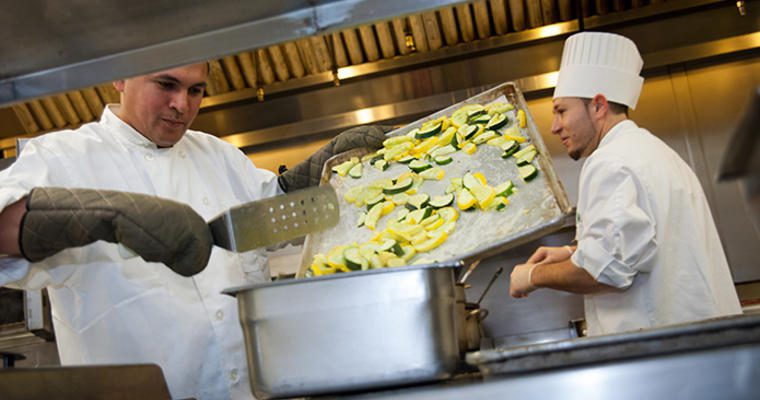Visit any care-center dining room and you’ll find people who grew up listening to Glenn Miller swing, Frank Sinatra croon, Chuck Berry rock, and Bob Dylan protest.
When it comes to healthcare foodservice, the challenge—whether the setting is a hospital, nursing home, assisted-living center, or senior community—is satisfying the tastes of a multigenerational client base. Or, as a baby boomer might put it: “Different strokes for different folks.”
Creating craveable menus means striking a balance between health-driven nutritional needs and the desire for delicious choices that meet nutritional guidelines, stay within budget, and assuring they can be—as much as possible—provided when patients or residents want it.
We are ushering in a culture change. In nursing centers, most residents are members of the silent generation but, incoming clients tend to be baby boomers. And, with hospitals transitioning patients into some form of assisted care, instances of more than one generation living and dining together will become more frequent.
Care centers of all types need to ask themselves: ‘Who lives here?’ ‘When was the last time I checked my menu?’ ‘Am I asking clients what they want to eat?’
Tradition and Beyond
Pay attention to what different generations desire and compare that to what your menu offers. This is critical to pleasing palates and attracting clients, according to the online senior-living resource aplaceformom.com. Residents of senior-living centers today are looking for a place to continue enriching their lives, and crave-worthy flavors are part of that equation.
The silent generation prefers meat and potatoes. Baby boomers also are predominantly traditional but have an adventurous streak. Meat and potatoes, yes, but they may prefer sweet-potato fries to a baked or mashed potato.
One big reason why boomers are more adventurous than the silent generation is travel. Gordon Food Service Nutrition Resource Center Menu Specialist Sharon Carter, RD, notes that members of the silent generation often saved up to take one big trip after retirement, whereas boomers traveled frequently throughout their working lives. Exposure to different cultures and different foods broadened their diets, a factor that care communities need to consider.
“Asian food can be a tough sell for the silent generation,” Carter says. “That was never part of their diet. Boomers, on the other hand, are more receptive to what they called ‘Chinese food’ while growing up.”
Shake Things Up and Satisfy
For the sake of nutrition, protein, calories, and flavor, senior-living centers are serving shakes as a satisfying flavor-delivery system that can easily be tailored to individual tastes, no matter the generation.
“A lot of shakes—such as banana-oat shakes, or an orange-creamsicle shake with ice cream and protein powder—are popular,” Carter says. “There’s even a rise-and-shine shake that has bananas, Greek yogurt, and orange juice.”
But flavor is only one part of the satisfaction equation. At senior-care centers and long-term-care settings, offering options and “anytime menus” in addition to the day’s main entrée, Carter advises, means there’s always a choice, just like at home. “Sure, you may like pork chops, but you may not feel like eating them today,” Carter says. “The ‘anytime menu’ is just like being able to open the fridge and choose something else—a burger, a fish sandwich, a grilled cheese.”
When it comes to feeding younger hospital patients, employees, or guests in the dining room, Carter favors a more trend-driven menu that emphasizes health and fl avor, with foods such as edamame and quinoa, and beverages infused with slices of fresh fruit and herbal accents.
Ultimately, no matter what audiences you serve, the goal is the same—customer satisfaction. So matching the right foods, on-trend flavors and food choices to patients, residents, employees, and guests is a step in the right direction.
Their Home, Their Choice
Being responsive to clients’ and guests’ tastes is essential, but so is accommodating their needs in other ways. Carter urges senior-living centers to adjust service to create a more homelike environment. For example, it’s no longer appropriate to serve breakfast from 7 a.m. to 9 a.m. only.
Hospitals also need to pay attention to hours of service. Providing food when a patient is hungry is important. The patient gets vital nutrients, and the hospital doesn’t waste food by serving a plate that’s not wanted and goes uneaten.“Ultimately, you don’t recover if you don’t eat,” Carter says. “And, when you do eat, it needs to be a good experience—evidence shows that food quality and dining service have a big impact on patient satisfaction.”
While not every satisfaction survey has questions directly related to foodservice, delivering personalized service and making diners happy makes a big difference when it comes to filling out scorecards.
“There are many things people in hospitals or senior centers can’t control, but food is one of the things they can control,” Carter says. “So if you’re not providing a choice for the different generations you’re serving, you’re missing a satisfaction opportunity.
Generational Food Preferences
The Silent Generation (Born 1945 and before)
They grew up during the Great Depression and World War II. Its members prefer simple, traditional foods:
- Roast turkey
- Meatloaf
- Grilled cheese
- Tomato soup
- Egg-salad sandwiches
- Mashed potatoes
- Green beans, peas, carrots
Baby Boomers (Born 1946-1965)
They like traditional foods with a twist. Think sweet potatoes instead of baked potatoes or shredded-beef tacos instead of steak:
- Fish and seafood
- Chinese food
- Sandwiches—
- besides burgers
- Mexican food
- Barbecue food
- Salad with ranch or
- Caesar dressing
- Beef dishes
Generation X (Born 1966-1976)
These diners are curious eaters who prefer more exotic foods:
- Mexican food
- Chinese food
- Japanese food/sushi
- Mediterranean
- Wood-fired pizza
- Herbal, authentic foods
Millennials (Born 1977-1992)
They value a wide variety of flavors and dining experiences:
- Chinese food
- Mexican food
- Barbecue
- Chicken dishes
- Breakfast food
- Cajun flavors
- Miso
Generation Z (Born 1993 and after)
They rank taste and flavor as most important. They like to be able to customize what they eat:
- Pizza
- Burgers
- Chinese food
- Mexican food
- Pasta dishes
- Veg-centric dishes




























